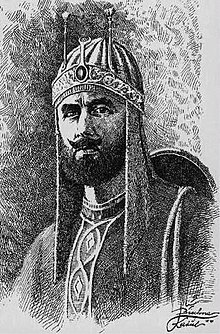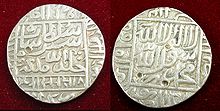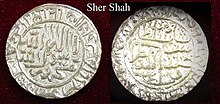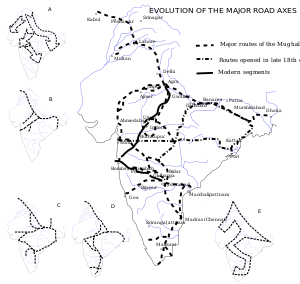Sher Shah Suri: Difference between revisions
Tradeupper88 (talk | contribs) minor change |
Undid revision 440657865 by Tradeupper88 (talk) if you keep it up then i'll have the page protected |
||
| Line 23: | Line 23: | ||
|}} |
|}} |
||
'''Sher Shah Suri''' (1486 - May 22, 1545) ({{lang-ps|''' |
'''Sher Shah Suri''' (1486 - May 22, 1545) ({{lang-ps|'''شیر شاہ سوری'''}} - ''Šīr Šāh Sūrī''), birth name '''Farid Khan''', also known as '''[[Shere Khan|Sher Khan]]''' (''The Lion King''), was an [[Pashtun people|Afghan]] [[emperor]] who founded the [[Sur dynasty]] with its capital at [[Delhi]] in [[India]].<ref name="Britannica">{{cite web |url=http://www.britannica.com/eb/article-9067304/Sher-Shah-of-Sur |title= Shēr Shah of Sūr|work=|publisher=Online [[Encyclopædia Britannica]]|year=2010|accessdate=2010-08-23}}</ref><ref>{{cite book|title=History of medieval India: from 1000 A.D. to 1707 A.D|last1=Chaurasia|first1=Radhey Shyam |authorlink=|coauthors=|volume=|year=2002|publisher=Crabtree Publishing Company|location=|isbn=8126901233|page=179|pages=337|url=http://books.google.com/books?id=8XnaL7zPXPUC&lpg=PP1&pg=PA179#v=onepage&q&f=false |accessdate=2010-08-23}}</ref><ref>{{cite book|title=The empire of the great Mughals: history, art and culture|last1=Schimmel|first1=Annemarie |authorlink=|coauthors=Burzine K. Waghmar|volume=|year=2004|publisher=Reaktion Books|location=|isbn=1861891857|page=28|pages=352|url=http://books.google.com/books?id=N7sewQQzOHUC&lpg=PP1&pg=PA28#v=onepage&q&f=false|accessdate=2010-08-23}}</ref><ref>{{cite book|title=Pakistan & the Karakoram Highway |last1=Singh|first1=Sarina|authorlink=|coauthors=Lindsay Brown; Paul Clammer; Rodney Cocks; John Mock|volume=7, illustrated|year=2008|publisher=Lonely Planet|location=|isbn=1741045428|page=137|pages=432|url=http://books.google.com/books?id=zn8I4qEew9oC&q=Pashtun+Sher+Shah+Suri#v=onepage&q&f=false|accessdate=2010-08-23}}</ref><ref>{{cite book|title=A Historical Atlas of Pakistan|last1=Greenberger|first1=Robert |authorlink=|coauthors=|volume=|year=2003|publisher=The Rosen Publishing Group |location=|isbn=0823938662|page=28|pages=64|url=http://books.google.com/books?id=RukebrLEpi4C&lpg=PA28&vq=Pashtun%20ruler%20of%20India&pg=PA28#v=onepage&q&f=false |accessdate=2010-08-23}}</ref> He first served as a [[private (rank)|private]] before rising to become a commander in the [[Mughal Army]] under [[Babur]] and then as the governor of [[Bihar]]. In 1537, when Babur's son [[Humayun]] was elsewhere on an expedition, Sher Khan overran the state of [[Bengal]] and established the [[Sur dynasty|Sur Empire]].<ref name="Columbia">{{cite web |url=http://www.infoplease.com/ce6/people/A0844870.html |title=Sher Khan|work=|publisher=[[Columbia Encyclopedia]]|year=2010|accessdate=2010-08-24}}</ref> |
||
A brilliant strategist, Sher Shah proved himself a gifted administrator as well as an able general. His reorganization of the empire laid the foundations for the later Mughal emperors, notably Akbar, son of Humayun.<ref name="Columbia"/> |
|||
During his five year rule from 1540 to 1545, he set up a new template for civic and military administration, issued the first ''[[Rupee]]'' and re-organised the postal system of India.<ref name="RBI"/> He further developed Humayun's ''Dina-panah'' city and named it [[Shergarh, India|Shergarh]] and revived the historical city of Pataliputra as [[Patna]] which had been in decline since the 7th century CE.<ref>[http://www.encyclopedia.com/doc/1E1-Patna.html Patna] encyclopedia.com.</ref> He is also famously remembered for killing a fully-grown [[tiger]] with his bare hands in a jungle of Bihar.<ref name="Britannica"/><ref name="Columbia"/> |
During his five year rule from 1540 to 1545, he set up a new template for civic and military administration, issued the first ''[[Rupee]]'' and re-organised the postal system of India.<ref name="RBI"/> He further developed Humayun's ''Dina-panah'' city and named it [[Shergarh, India|Shergarh]] and revived the historical city of Pataliputra as [[Patna]] which had been in decline since the 7th century CE.<ref>[http://www.encyclopedia.com/doc/1E1-Patna.html Patna] encyclopedia.com.</ref> He is also famously remembered for killing a fully-grown [[tiger]] with his bare hands in a jungle of Bihar.<ref name="Britannica"/><ref name="Columbia"/> |
||
Revision as of 20:14, 21 July 2011
| Sher Shah Suri | |
|---|---|
| Emperor of Sur Empire | |
 | |
| Reign | 1540–1545 |
| Coronation | 1540 |
| Predecessor | Humayun |
| Successor | Islam Shah Suri |
| Born | 1486 Sasaram, Rohtas district in India[1] |
| Died | May 22, 1545 Kalinjar, Bundelkhand |
| Burial | Sher Shah Suri Tomb, Sasaram |
| House | Sur dynasty |
| Dynasty | Sur dynasty |
| Father | Mian Hassan Khan Sur |
| Religion | Sunni Islam |
Sher Shah Suri (1486 - May 22, 1545) (Pashto: شیر شاہ سوری - Šīr Šāh Sūrī), birth name Farid Khan, also known as Sher Khan (The Lion King), was an Afghan emperor who founded the Sur dynasty with its capital at Delhi in India.[2][3][4][5][6] He first served as a private before rising to become a commander in the Mughal Army under Babur and then as the governor of Bihar. In 1537, when Babur's son Humayun was elsewhere on an expedition, Sher Khan overran the state of Bengal and established the Sur Empire.[7]
A brilliant strategist, Sher Shah proved himself a gifted administrator as well as an able general. His reorganization of the empire laid the foundations for the later Mughal emperors, notably Akbar, son of Humayun.[7]
During his five year rule from 1540 to 1545, he set up a new template for civic and military administration, issued the first Rupee and re-organised the postal system of India.[8] He further developed Humayun's Dina-panah city and named it Shergarh and revived the historical city of Pataliputra as Patna which had been in decline since the 7th century CE.[9] He is also famously remembered for killing a fully-grown tiger with his bare hands in a jungle of Bihar.[2][7]
Early life and origin
Sher Shah was born as Farid Khan in the Hisar district of India, according to Tarikh-i Khan Jahan Lodi (MS. p. 151).[1] However, the online Encyclopædia Britannica states that he was born in Sasaram, in the Rohtas district.[2] He was one of about eight sons of Mian Hassan Khan Sur, a prominent figure in the government of Bahlul Khan Lodi. Sher Khan belonged to the Pashtun Sur tribe (the Pashtuns are known as Afghans in historical Persian language sources).[10] His grandfather, Ibrahim Khan Sur, was a noble adventurer who was recruited much earlier by Sultan Bahlul Lodi of Delhi during his long contest with the Jaunpur Sultanate.
It was at the time of this bounty of Sultán Bahlol, that the grandfather of Sher Sháh, by name Ibráhím Khán Súri,*[The Súr represent themselves as descendants of Muhammad Súri, one of the princes of the house of the Ghorian, who left his native country, and married a daughter of one of the Afghán chiefs of Roh.] with his son Hasan Khán, the father of Sher Sháh, came to Hindu-stán from Afghánistán, from a place which is called in the Afghán tongue “Shargarí,”* but in the Multán tongue “Rohrí.” It is a ridge, a spur of the Sulaimán Mountains, about six or seven kos in length, situated on the banks of the Gumal. They entered into the service of Muhabbat Khán Súr, Dáúd Sáhú-khail, to whom Sultán Bahlol had given in jágír the parganas of Hariána and Bahkála, etc., in the Panjáb, and they settled in the pargana of Bajwára.[1]
— Abbas Khan Sarwani, 1580
During his early age, Farid was given a village in Fargana, Shahabad (comprising present day districts of Bhojpur, Buxar, Bhabhua of Bihar), by Bahlul Khan Lodi's counsellor and courtier, Omar Khan. Farid Khan and his father, who had several wives, did not get along for a while so he decided to run away from home. When his father discovered that he fled to serve Jamal Khan, the governor of Jaunpur, Uttar Pradesh, he wrote Jamal Khan a letter that stated:
"Faríd Khán, being annoyed with me, has gone to you without sufficient cause. I trust in your kindness to appease him, and send him back; but if refusing to listen to you, he will not return, I trust you will keep him with you, for I wish him to be instructed in religious and polite learning."[11]
Jamal Khan had advised Farid to return home but he refused. Farid replied in a letter:
"If my father wants me back to instruct me in learning, there are in this city many learned men: I will study here."[11]
While he was away in Jaunpur, Farid began to learn Arabic language, history, and works of philosophers. Farid and his father later united and began working together. He started reforming the administration of his father by introducing new ways. He also began training and organizing an army force. Farid later became known as Sher Khan after he killed a full-sized tiger (sher) with his bare hands. Particularly for this event and generally for his ferocity as a warrior, he was then, later on, called Sultan-e-Azam Sher Shah Suri meaning the great lion emperor Sher Shah Suri. After resoration of Mughal Empire his family and grandchildren relocated to the Middle East creating more than 10 families such as Shakhshir , Shakhashero And Shakhshery , these family names are referring to Sher Shah inverting his name as Arabic language was read from right to left.[2][7]
Government and administration



Sher Shah became a commander by Babur after serving previously as a private in the Mughal army. After becoming the governor of Bihar, he began reorganizing the administration efficiently. He organised a well disciplined, one of the largest and most efficient army. He also introduced tax collection system, built roads along with resting areas for travellers, dug wells, improved the jurisdiction, founded hospitals, established free kitchens, organized mail services and the police. His management proved so efficient that even one of the greatest rulers of human history, the Mughal Emperor Akbar, organised the South Asia on his measures, and the system which lasted until the 20th century.
He is also credited with rebuilding the longest highway in South Asia. The highway called the "Shahrah-e-Azam"/Sadak-e-Azam or the "Badshahi Sadak" (renamed "Grand Trunk Road" by the British) survives til this day. It is in use in present-day Khyber Pakhtunkhwa, Punjab region Punjab, Delhi, Uttar Pradesh, Bihar and Bengal, however he never himself came to Dhaka.
Sher Shah was a visionary ruler and introduced many military and civil reforms. The system of tri-metalism which came to characterise Mughal coinage was largely the creation of Sher Shah Suri. He also minted a coin of silver which was termed the Rupiya that weighed 178 grains and was the precursor of the modern rupee.[8] The same name is still used for the national currency in Pakistan, India, Nepal, Sri Lanka, Indonesia, Mauritius, Maldives, Seychelles among other countries. Gold coins called the Mohur weighing 169 grains and copper coins called Dam were also minted by his government.[8][12]
Mirza Aziz Koka, son of Ataga Khan, and probably Akbar's closest friend and one of the most important mansabdar's of the Mughal Empire, wrote this to Emperor Jahangir in one of his personal letters to him:
"Specially Sher Khan was not an angel (malak) but a king (malik). In six years he gave such stability to the structure (of the empire) that its foundations still survive. He had made India flourish in such a way that the king of Persia and Turan appreciate it, and have a desire to look at it. Hazrat Arsh Ashiyani (Akbar the great) followed his administrative manual (zawabit) for fifty years and did not discontinue them. In the same India due to able administration of the well wishers of the court, nothing is left except rabble and jungles..."
Death and succession

Sher Shah Suri died from a gunpowder explosion during the siege of Kalinjar fort on May 22, 1545 fighting against the Chandel Rajputs.
Sher was also the last and the main personality of India to offer serious {{citation}}: Empty citation (help) resistance to the Mughals on their advance to the south, and his death during the siege of Kalinjar (Bundelkhand) in 1545, cleared the path to the return of Mughal emperor Humayun.
Sher Shah Suri was succeeded by his son, Jalal Khan who took the title of Islam Shah Suri, and his imposing and proud mausoleum, the Sher Shah Suri Tomb (122 ft high) stands in the middle of an artificial lake at Sasaram, a town that stands on the Grand Trunk Road, his lasting legacy.[13] His death has also been claimed to have been caused by a fire in his store room.
Tarikh-i-Sher Shahi (History of Sher Shah), written by Abbas Khan Sarwani, a waqia-navis under later Mughal Emperor, Akbar around 1580, provides a detailed documentation about Sher Shah's administration.
Legacy

Recent research indicates that during the time of the Maurya empire in the 3rd century BC, overland trade between India and several parts of western Asia and the Hellenic world went through the cities of the north-west, primarily Taxila (located in present day Pakistan)(see inset in map). Taxila was well connected by roads with other parts of the Maurya empire. The Mauryas had built a highway from Taxila to Pataliputra (present-day Patna in Bihar, India). Great Chandragupta Maurya had a whole army of officials overseeing the maintenance of this road as told by the Greek diplomat Megasthenes who spent fifteen years at the Mauryan court.
In the 16th century, a major road running across the Gangetic plain was built afresh by Pashtun emperor Sher Shah Suri, who then ruled much of northern India. His intention was to link together the remote provinces of his vast empire for administrative and military reasons. The Sadak-e-Azam ("great road") as it was then known, is universally recognized as the precursor of the Grand Trunk Road.

The road was initially built by Sher Shah to connect Agra, his capital, with Sasaram, his hometown. It was soon extended westward to Multan and eastward to Sonargaon in Bengal (now in Bangladesh). While Sher Shah died after a brief reign, and his dynasty ended soon afterwards, the road endured as his outstanding legacy. The Mughals, who succeeded the Suris, extended the road westwards: at one time, it extended to Kabul in Afghanistan, crossing the Khyber Pass. This road was later improved by the British rulers of colonial India. Renamed the "Grand Trunk Road" (sometimes referred to as the "Long Walk"), it was extended to run from Calcutta to Peshawar and thus to span a major portion of India.
Over the centuries, the road, which was one of the most important trade routes in the region, facilitated both travel and postal communication. Even during the era of Sher Shah Suri, the road was dotted with caravansarais (highway inns) at regular intervals, and trees were planted on both sides of the road to give shade to the passers-by. The road was well planned, with milestones along the whole stretch. Some of these milestones can still be seen along the present Delhi-Ambala highway. On another note, the road also facilitated the rapid movement of troops and of foreign invaders. It expedited the looting raids, into India's interior regions, of Afghan and Persian invaders and also facilitated the movement of British troops from Bengal into the north Indian plain.
The Grand Trunk Road continues to be one of the major arteries of India and Pakistan. The Indian section is part of the ambitious Golden Quadrilateral project. For over four centuries, the Grand Trunk Road has remained "such a river of life as nowhere else exists in the world".[14]
Architectural legacy
Apart from rebuilding the Grand Trunk Road also known as Shahar Rah-e-Azam ("great road"), which stretches across the breadth of South Asia from Sonargaon in Bangladesh to Peshwar in Pakistan, he built monuments, many of which no longer exist today, including Rohtas Fort, now a UNESCO World Heritage Site in Pakistan, many structures in the Rohtasgarh Fort in Bihar, Sher Shah Suri Masjid, in Patna, built in 1540-1545 to commemorate his reign.
Qila-i-Kuhna mosque, built by Sher Shah in 1541, at Purana Qila, Delhi, a Humayun citadel started in 1533, and later extended by him, along with the construction of Sher Mandal, an octagonal building inside the Purana Qila, Delhi complex, which later served as the library of Humayun.
-
Presently a part of Comilla's Court Road, the photographed street had once been an extension of Grand Trunk Road, to communicate with the port facilities of Chittagong
-
Lal Darwaza or Sher Shah Gate, the Southern Gate to the Sher Shah Suri's city, Shergarh, opposite Purana Qila, Delhi, also showing with the adjoining curon walls and bastions
-
Rohtas Fort's magnificent Kabuli Gate
-
Qila-i-Kuhna mosque, built by Sher Shah in 1541, Purana Qila, Delhi
-
Sher Mandal built by Sher Shah, Purana Qila, Delhi
Shersabadia community
Some soldiers were left behind by Sher Shah Suri as he escaped from Bengal, avoiding the Humayun invasion. These people are known as Shersabadia. They made a colony named Shershahabad which is no more due to a course change of Ganges. Today the people of this community are found in parts of Malda, Murshidabad, Chapai Nawabganj and a few other parts of Bengal
Karachi
Sher Shah neighbourhood and Sher Shah Bridge in Kiamari Town of Karachi, Pakistan, are named in the honour of Sultan Sher Shah Suri.
Additional reading
- Tarikh-i-Sher Shahi
- Tarikh-e-Afghani
- Tarikh-i Khan Jahani wa Makhzan-i Afghani
- Edward Thomas (1871) The Chronicles of the Pathan Kings of Delhi
- Kalkar Nijan, Sher Shah And His Times
- Sir Olaf Caroe, The Pathans
- Syed Bahadur Shah Zafar Kakakhel, Pashtoon
- Burgess, James (1913). The Chronology of Modern India for Four Hundred Years from the Close of the Fifteenth Century, AD. 1494-1894. John Grant, Edinburgh.
See also
- Delhi Sultanate
- Shere Khan
- Pathan of Bihar
- List of rulers of Bengal
- History of Bengal
- History of Bangladesh
- History of India
References
- ^ a b c Abbas Khan Sarwani (1580). "Táríkh-i Sher Sháhí; or, Tuhfat-i Akbar Sháhí, of 'Abbás Khán Sarwání. CHAPTER I. Account of the reign of Sher Sháh Súr". Sir H. M. Elliot. London: Packard Humanities Institute. p. 78. Retrieved 2010-09-04.
- ^ a b c d "Shēr Shah of Sūr". Online Encyclopædia Britannica. 2010. Retrieved 2010-08-23.
- ^ Chaurasia, Radhey Shyam (2002). History of medieval India: from 1000 A.D. to 1707 A.D. Crabtree Publishing Company. p. 179. ISBN 8126901233. Retrieved 2010-08-23.
{{cite book}}: Cite has empty unknown parameter:|coauthors=(help); More than one of|pages=and|page=specified (help) - ^ Schimmel, Annemarie (2004). The empire of the great Mughals: history, art and culture. Reaktion Books. p. 28. ISBN 1861891857. Retrieved 2010-08-23.
{{cite book}}: More than one of|pages=and|page=specified (help); Unknown parameter|coauthors=ignored (|author=suggested) (help) - ^ Singh, Sarina (2008). Pakistan & the Karakoram Highway. Vol. 7, illustrated. Lonely Planet. p. 137. ISBN 1741045428. Retrieved 2010-08-23.
{{cite book}}: More than one of|pages=and|page=specified (help); Unknown parameter|coauthors=ignored (|author=suggested) (help) - ^ Greenberger, Robert (2003). A Historical Atlas of Pakistan. The Rosen Publishing Group. p. 28. ISBN 0823938662. Retrieved 2010-08-23.
{{cite book}}: Cite has empty unknown parameter:|coauthors=(help); More than one of|pages=and|page=specified (help) - ^ a b c d "Sher Khan". Columbia Encyclopedia. 2010. Retrieved 2010-08-24.
- ^ a b c "Mughal Coinage". Reserve Bank of India RBI Monetary Museum. Retrieved 2010-08-24.
- ^ Patna encyclopedia.com.
- ^ Weiner, Myron (1994). The Politics of social transformation in Afghanistan, Iran, and Pakistan. Syracuse University Press. p. 488. ISBN 0815626088, 9780815626084. Retrieved 2006-06-07.
{{cite book}}: Check|isbn=value: invalid character (help); Unknown parameter|coauthors=ignored (|author=suggested) (help) - ^ a b Abbas Khan Sarwani (1580). "Táríkh-i Sher Sháhí; or, Tuhfat-i Akbar Sháhí, of 'Abbás Khán Sarwání. CHAPTER I. Account of the reign of Sher Sháh Súr". Sir H. M. Elliot. London: Packard Humanities Institute. p. 79. Retrieved 2010-09-04.
- ^ Rupee This article incorporates text from a publication now in the public domain: Chisholm, Hugh, ed. (1911). Encyclopædia Britannica (11th ed.). Cambridge University Press.
{{cite encyclopedia}}: Missing or empty|title=(help). - ^ Catherine B. Asher (1977). "The mausoleum of Sher Shah Suri". Artibus Asiae. 39 (3/4). Artibus Asiae Publishers: 273–298. doi:10.2307/3250169.
- ^ A description of the road by Kipling, found both in his letters and in the novel "Kim". He writes: "Look! Brahmins and chumars, bankers and tinkers, barbers and bunnias, pilgrims -and potters - all the world going and coming. It is to me as a river from which I am withdrawn like a log after a flood. And truly the Grand Trunk Road is a wonderful spectacle. It runs straight, bearing without crowding India's traffic for fifteen hundred miles - such a river of life as nowhere else exists in the world."





